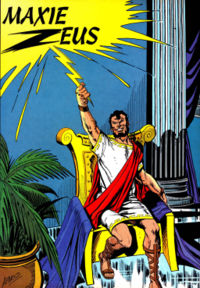
The Elizabeth Arkham Asylum for the Criminally Insane, commonly referred to as Arkham Asylum, is a fictional psychiatric hospital/prison, appearing in American comic books published by DC Comics, commonly in stories featuring the superhero Batman. It first appeared in Batman #258, written by Dennis O'Neil with art by Irv Novick. The asylum serves as a (forensic) psychiatric hospital for the Gotham City area, housing patients who are criminally insane, as well as select prisoners with unusual medical requirements that are beyond a conventional prison's ability to accommodate. Its high-profile patients are often members of Batman's rogues gallery.
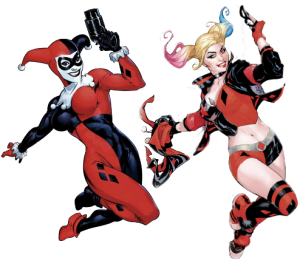
Harley Quinn is a character appearing in American comic books published by DC Comics. She was created by Paul Dini and Bruce Timm for Batman: The Animated Series as a henchwoman for the Joker, and debuted in its 22nd episode, "Joker's Favor", on September 11, 1992. While intended to appear in one episode, Quinn became a recurring character within the DC Animated Universe (DCAU) as the Joker's sidekick and love interest, and was adapted into DC Comics' canon seven years later, beginning with the one-shot Batman: Harley Quinn #1. Quinn's origin story features her as a former psychologist at Gotham City's Arkham Asylum who was manipulated by and fell in love with the Joker, her patient, eventually becoming his accomplice and lover. The character's alias is a play on the stock character Harlequin from the 16th-century Italian theater commedia dell'arte.

James W. "Jim" Gordon is a fictional character appearing in American comic books published by DC Comics, most commonly in association with the superhero Batman. Created by Bill Finger and Bob Kane as an ally of Batman, the character debuted in the first panel of Detective Comics #27, Batman's first appearance, making him the first Batman supporting character ever to be introduced.

Hugo Strange is a supervillain appearing in comic books published by DC Comics, commonly as an adversary of the superhero Batman. The character is one of Batman's first recurring villains, and was also one of the first to discover his secret identity. The character first appeared in Detective Comics #36.

The Mad Hatter is a supervillain appearing in comic books published by DC Comics, commonly as an adversary of the superhero Batman. He is modeled after the Hatter from Lewis Carroll's novel Alice's Adventures in Wonderland, a character often called the "Mad Hatter" in adaptations of Carroll. A scientist who invents and uses technological mind control devices to influence and manipulate the minds of his victims, the Mad Hatter is one of Batman's most enduring enemies and belongs to the collective of adversaries that make up Batman's rogues gallery.
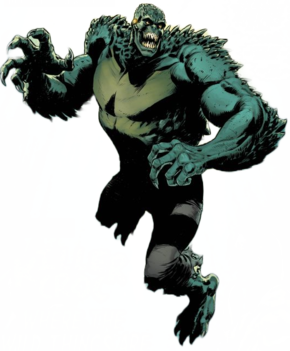
Killer Croc is a supervillain appearing in American comic books published by DC Comics. Created by Gerry Conway, Don Newton and Gene Colan, the character was introduced in Batman #357. He has become one of the most enduring enemies of the superhero Batman and belongs to the collective of adversaries that make up his rogues gallery.
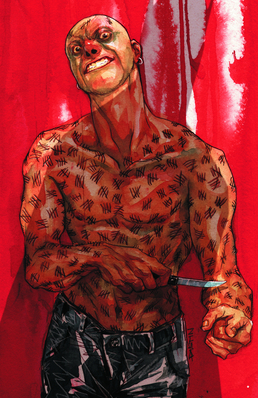
Victor Zsasz, also known as Mr. Zsasz or simply Zsasz, is a supervillain appearing in comic books published by DC Comics. The character first appeared in Batman: Shadow of the Bat #1. He is a sadomasochistic and psychopathic serial killer who carves a tally mark onto himself for each of his victims. A recurring adversary of the superhero Batman, Zsasz belongs to the collective of enemies that make up Batman's rogues gallery.

Firefly is a supervillain appearing in American comic books published by DC Comics. Created by France Herron and Dick Sprang, he made his debut in Detective Comics #184. Initially portrayed as a criminal who utilized lighting effects to commit robberies, Firefly was later reimagined as a sociopathic pyromaniac with an obsessive compulsion to start fires following Crisis on Infinite Earths' reboot of the DC Universe in the 1980s. This darker depiction of the character has since endured as one of the superhero Batman's most recurring enemies and belongs to the collective of adversaries that make up his central rogues gallery.

Hush is a supervillain appearing in American comic books published by DC Comics. Created by Jeph Loeb and Jim Lee, the character first appeared in Batman #609 in January 2003 as part of the twelve-issue storyline Batman: Hush. Hush serves as a criminal foil to the superhero Batman and belongs to the collective of adversaries that make up his rogues gallery.

Professor Achilles Milo is a fictional character appearing in American comic books published by DC Comics.

The Electrocutioner is an alias used by three fictional characters in the DC Universe, all minor enemies of the superhero Batman.
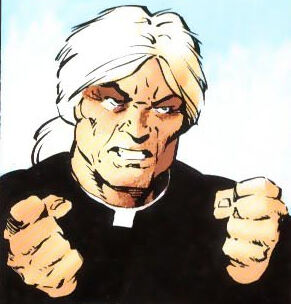
Deacon Joseph Blackfire is a supervillain appearing in American comic books published by DC Comics. Blackfire is stated as being over 100 years old, and is often portrayed as a power-crazed charismatic con artist and cult leader skilled in manipulation and brainwashing. Blackfire claimed to be a Native American shaman who was entombed alive after being found guilty of killing a tribal chief and committing heresy.
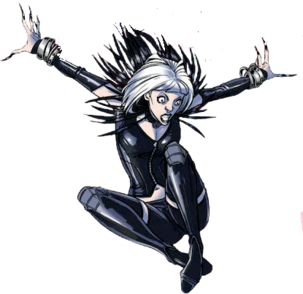
Magpie is a supervillain appearing in American comic books published by DC Comics. She was created by John Byrne, and first appeared in The Man of Steel #3.
Originally created in 1967, the fictional comic book character Barbara Gordon has been adapted into various other forms of media. The character has appeared in both live action and animated television series and films, as well as in video games in her alter-egos as both Batgirl and Oracle!.

Tweedledum and Tweedledee are a duo of supervillains appearing in comic books published by DC Comics, primarily as enemies of Batman.

The Joker, a supervillain in DC Comics and archenemy of the superhero Batman, has appeared in various media. WorldCat records over 250 productions featuring the Joker as a subject, including films, television series, books, and video games. Live-action films featuring the character are typically the most successful.
The Dollmaker is the name of several supervillains appearing in American comic books published by DC Comics.

The Riddler, a supervillain in DC Comics and an adversary of the superhero Batman, has been adapted into numerous forms of media, including feature films, television series, and video games. The character has been portrayed in live-action by Frank Gorshin and John Astin in the 1960s television series Batman, Jim Carrey in the 1995 film Batman Forever, Cory Michael Smith in the 2014 Fox series Gotham, and Paul Dano in the 2022 film The Batman. Actors who have voiced the Riddler include John Glover in the DC Animated Universe, Robert Englund in The Batman, and Wally Wingert in the Batman: Arkham video games.

The Scarecrow, a supervillain in DC Comics and an adversary of the superhero Batman, has been adapted in various forms of media, including films, television series, and video games. The character has been portrayed in film by Cillian Murphy in The Dark Knight Trilogy, and in television by Charlie Tahan and David W. Thompson in the Fox series Gotham, and Vincent Kartheiser in the HBO Max streaming series Titans. Henry Polic II, Jeffrey Combs, Dino Andrade, John Noble, Robert Englund, and others have provided the Scarecrow's voice in animation and video games.

The character Two-Face was created by Bob Kane and first appeared in Detective Comics #66. However, he did not appear outside comics until half a century later in Batman: The Animated Series. Two-Face has since been substantially adapted from the comics into various forms of media, such as feature films, television series and video games. Two-Face has been voiced by Richard Moll in the DC Animated Universe, Troy Baker in the Batman: Arkham series, Billy Dee Williams in The Lego Batman Movie, and William Shatner in Batman vs. Two-Face. His live-action portrayals include Billy Dee Williams in Batman (1989), Tommy Lee Jones in Batman Forever, Aaron Eckhart in The Dark Knight, and Nicholas D'Agosto in the television series Gotham. In 2009, Two-Face was ranked #12 on IGN's list of the Top 100 Comic Book Villains of All Time.
